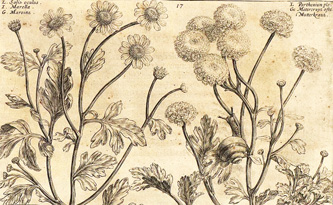Friendly Feverfew
By Audrey Stallsmith

Like blue-eyed hope, its starry blooms
Wave by the road and rill,
And by the humble village tombs,
And on the gusty hill.
"The Feverfew," T. P. Bell
Oddly enough, feverfew originally wasn’t used to cure fever. In ancient times, it was called "parthenion" and then "featherfoil" for its feathery leaves. "Featherfoil" evolved into "featherfew" and eventually "feverfew." Once “fever” was in the name, people naturally expected the herb to be able to cool high temperatures!
Its real talent, however, lies elsewhere. As Michael Castleman mentions in The Healing Herbs, feverfew is “remarkably effective at preventing migraine headaches.” Actually, just looking at the little plant, which grows to about 2 feet with cheerful daisy-like flowers, is probably enough to soothe an aching brow.
It has borne a variety of botanical names, including Tanacetum, Chrysanthemum or Pyrethrum parthenium, which hint at its relationship to tansy, mum, and painted daisy. Like them, it has a spicy scent – attractive to some people but reportedly repellant to bees and sensitive noses -- and its resemblance to chamomile frequently gets it confused with that plant as well.
I started some seedlings of an anemone-flowered double variety called 'White Bonnet' this spring and look forward to seeing them bloom. Because the flowers are somewhat long-lasting in bouquets, like those of mums, they used to be popular in nosegays. In An Old-Fashioned Girl, Louisa May Alcott mentions one such “posy of scarlet verbenas, white feverfew, and green leaves.”
In addition to curing headaches, feverfew reportedly can reduce blood pressure, soothe menstrual cramps, treat coughs, and even relieve an opium hangover. If you wish to try it, keep in mind that the herb tastes bitter and can cause stomach aches or mouth sores in some people. It also thins the blood, so it probably should be avoided by patients already on blood thinning medications.
For many migraines sufferers, however, the herb has proved the “beneficence” (helpfulness) for which it stands in The Language of Flowers. We must admit, though, that the more accurate "headachefew" just wouldn’t have the same ring to it!
The Tanacetum parthenium image is from Hortus Floridus by C. Van de Passe, courtesy of plantillustrations.org.








